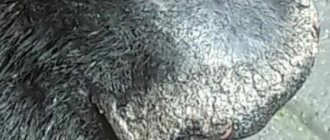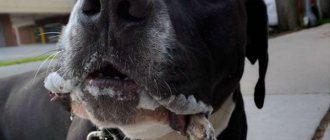Types of seizures
Seizures in dogs are divided into four types.
- Convulsions are small, jerky muscle spasms. The animal is able to remain on its feet, does not lose consciousness, and responds to commands. Externally, convulsions look like twitching and may not immediately attract the owner’s attention.
- Tonic convulsions - veterinarians consider their manifestation not too serious a threat, since these are short-term muscle contractions. However, the pet is in pain. During tonic spasms, the dog is conscious and what is happening frightens it. She may whine and become confused in a familiar, homely environment. It is easy to identify this species externally thanks to slow twitching at the same time interval.
- Clonic convulsions - a distinctive feature is a long period of time. This is a seizure in which dogs experience repeated bouts of convulsions once every 30 seconds to two minutes. The spasm goes away and the dog tries to get up, but soon a new wave of the attack makes him fall again. The animal is in pain. It is difficult to react to an unexpected condition.
- Epileptic seizure - from the name it is clear that this type of illness is dangerous and severe. It is characterized by: complete loss of consciousness, tension and constant muscle contraction. The animal's eyes are often closed, but an attack is possible with open eyes without signs of reaction. The dog is in pain. After a seizure, he does not recover immediately. The gait will be unsteady and swaying. The state is sluggish.
Types of colic in dogs
Many breeders consider colic to be a consequence of “problems” with the digestive system; in fact, it is a complex and complex problem, which is sometimes caused by the influence of several diseases at once.
For ease of identification and treatment, there is a simple veterinary classification in which all these pathologies are divided into the following types:
- Colic is true, “canonical”. They occur only in diseases of the gastrointestinal tract (i.e. stomach and/or intestines).
- False group. These are colics that occur due to pathologies of the liver, gall bladder, kidneys, bladder, etc.
Veterinarians also divide true colic into categories. We will not delve into the jungle of classification: simple breeders only need to know that they are divided into gastric and intestinal.
- In the first case, colic is often caused by an expansion of the stomach (there can be many reasons for this).
- But intestinal colic is much more dangerous. They can also be divided into two groups: relatively simple, when the pathological condition is not accompanied by the development of peritonitis, and complex, when peritonitis has either already developed or there is a high probability of its occurrence.
Intestinal
Intestinal colic is one of the most dangerous. And it’s not even a matter of pain or spasms. This group of pathologies often leads to peritonitis, which is often fatal even if promptly consulted by a veterinarian.
The most dangerous are ileus (various pathologies leading to intestinal obstruction) and thromboembolism of the mesenteric veins (i.e. blockage of the veins of the mesentery of the intestines). In the first case, the intestines can mechanically rupture, in the second, they begin to rot due to lack of nutrition (and also subsequently rupture). All this is accompanied by terrible pain and spasms.
Hepatic
They fall into the category of false. But this does not mean that hepatic colic is easier. As a rule, they develop against the background of blockage of the bile ducts and the gallbladder itself.
Causes
Seizures in dogs have reasonable causes. This is a visible manifestation of the disease. Only a qualified veterinarian can establish a connection between muscle spasms and disease, but every owner should be aware of diseases with such manifestations.
- Eclampsia. The disease occurs due to a lack of calcium in the body. Animals of small breeds weighing up to 5 kg are most often affected. Pregnant and lactating bitches are especially susceptible. The result of a long-term lack of calcium in the blood is convulsions.
- Hypoglycemia and hyperglycemia - there is not enough glucose in the blood or there is an excess. Both are deviations from the norm that cause metabolic disorders. Kidneys and liver suffer. When neglected, it leads to serious damage to internal organs and the brain. The disease can be hereditary and acquired as a result of an improper diet.
- Intoxication of the body caused by any reason - poisoning, bites of poisonous animals, insects, advanced disease - is also the cause of seizures. One of them is hyperammonemia - dysfunction of the kidneys. The body poisons itself with untimely elimination of the breakdown products of substances.
- Injuries to the spine, head, internal organs.
- Infectious diseases are a common cause of uncontrolled convulsions. Dangerous to humans - rabies.
Epilepsy, as a cause of prolonged, painful seizures, deserves separate consideration. It occurs due to disturbances in the functioning of the brain due to a tumor, injury, inflammation, previous or untreated infectious disease, or heredity.
Epilepsy is in most cases a genetic disorder. Therefore, pets suffering from this disease are not recommended to reproduce. Next, there are acquired causes that affect the brain:
- Intoxication.
- Plague, toxoplasmosis, tetanus.
- Snake and insect bites.
- Helminths.
- Skull injuries.
- Malnutrition.
- Kidney diseases, cirrhosis.
- Diabetes.
- Hypovitaminosis.
- Mineral deficiency.
- Arrhythmia, brain cancer.
- Electric shock.
Often, due to inexperience, seizures are confused with a drunken gait of an animal, the cause of which is degenerative myelopathy. Rhythmic twitching during sleep is normal for puppies. And old dogs can tremble in their sleep and even whine. However, this is also a normal phenomenon and is completely different from painful cramps.
Video
Authors):
Roberto A. Santilli Med.Vet., PhD, DECVIM-CA (Cardiology)
Organization(s):
Clinica veterinaria Malpensa-Samarate-Varese-Italy Ospedale Veterinario I Portoni Rossi – Zola Predosa – Bologna – Italy Cornell University- cardiology department_New York – USA
Magazine:
No. 3 - 2017
IVCS MATERIALS
translation from English by Maria Nazarova
Introduction
Transient loss of consciousness (TLOC) is a brief loss of consciousness with sudden onset, short duration, and spontaneous and rapid recovery. The main forms of TLOC are: traumatic loss of consciousness, or concussion, and non-traumatic loss of consciousness, which in turn is divided into: syncope, epileptic seizure and various groups of rare disorders such as catalepsy.
Syncope is loss of consciousness due to global cerebral hypoperfusion due to a drop in systemic blood pressure due to a sharp decrease in vascular resistance or a drop in heart rate.
The typical syncope is short. Complete loss of consciousness in cases of reflex syncope lasts no more than 20 seconds. However, fainting rarely lasts longer, up to several minutes. In such cases, differentiating the diagnosis between syncope and other causes of loss of consciousness may be difficult. Recovery from syncope is usually accompanied by an immediate return to normal behavior and orientation. Fatigue may sometimes be noticeable during the recovery period. Presyncope is a term used to identify the precursor to fainting, but this stage is not accompanied by loss of consciousness. A sudden cessation of blood flow to the brain for a short period of just 6–8 seconds is enough to cause complete loss of consciousness. Systemic blood pressure is determined by cardiac output and total peripheral vascular resistance, and a fall in either of these parameters causes syncope, but a combination of a fall in both may also occur, with varying degrees of severity for each component.
Low or inadequate peripheral vascular resistance may result from an inadequate reflex response, which leads to vasodilation and bradycardia and is referred to as vasodepressor, mixed, or cardioinhibitory reflex syncope. Other causes of inadequate peripheral vascular resistance are functional and structural damage to the autonomic nervous system, such as dysautonomia (due to, for example, drug therapy). In the case of disturbances in the functioning of the autonomic nervous system, the sympathetic vasomotor pathways are unable to provide an increase in total peripheral vascular resistance (TPVR) in response to a change in body position (from lying to standing). Gravitational stress, in combination with vasomotor insufficiency, leads to the deposition of blood in the veins of the abdominal cavity and pelvic extremities, causing a sharp decrease in preload (venous return) and, as a consequence, cardiac output. The causes of a transient decrease in cardiac output are: reflex bradycardia, known as the cardioinhibitory type of reflex syncope, cardiovascular diseases (arrhythmias, structural diseases, pulmonary embolism and pulmonary hypertension), inadequate venous return due to emptying of the veins or deposition of blood in the veins. According to the underlying mechanism, fainting is divided into: reflex, orthostatic and cardiogenic.
Reflex fainting
Reflex syncope traditionally refers to a heterogeneous group of conditions in which cardiovascular reflexes that normally control circulation become intermittently inappropriate in response and act as triggers, causing vasodilation and/or bradycardia, thereby leading to a drop in blood pressure and global cerebral hypoperfusion . Reflex syncope is usually classified based on the efferent pathways most involved, i.e., sympathetic or parasympathetic. The term "vasodepressor" type usually means that hypotension predominates due to loss of vasoconstrictor tone during standing. The “cardioinhibitory” type is used when bradycardia or asystole predominate, the “mixed” type is used when both mechanisms (*vasodepressor and cardioinhibitory) are present. Vasovagal syncope is caused by pain, emotional or orthostatic stress. There are usually previous symptoms of activation of the autonomic nervous system (pallor, nausea). Situational fainting traditionally refers to reflexive, associated with certain circumstances (coughing, urination, defecation, vomiting, pain, physical activity). Syncope due to carotid sinus stimulation is a rare, sudden disorder caused by mechanical manipulation of the carotid sinus.
Orthostatic syncope
In contrast to reflex syncope, in dysautonomia, sympathetic efferent activity is impaired and there is a deficit in vasoconstriction. When standing, the pressure drops and fainting or near-syncope occurs. Orthostatic hypotension is defined as an abnormal decrease in systolic blood pressure when the body changes position to standing. Orthostatic intolerance can cause fainting, but also dizziness, lightheadedness, weakness, fatigue and lethargy.
Classically, orthostatic hypotension is characterized by a decrease in systolic pressure by more than 20 mmHg. Art. and diastolic - more than 10 mm Hg. Art. within 3 minutes after taking a standing position.
Orthostatic hypotension may be caused by structural damage to the autonomic nervous system, medications that cause autonomic failure, and inadequate venous return due to decreased blood volume or pooling of blood in the veins.
Cardiogenic syncope
Structural diseases of the cardiovascular system (valvular disease, ischemia, hypertrophic cardiomyopathy, cardiac neoplasms, pericardial disease and tamponade), pulmonary embolism or pulmonary hypertension can cause syncope, and they are associated with the fact that the body's needs cannot be met by the impaired ability of the heart increase your emissions. The basis for syncope is inadequate blood flow resulting from mechanical obstruction.
However, in some cases, syncope not only results from decreased cardiac output, but may also be caused in part by an inappropriate reflex response or orthostatic hypotension.
Arrhythmias are the most common cause of cardiogenic syncope. They cause hemodynamic disturbances, which lead to a critical decrease in cardiac output and blood flow in the brain. Fainting often depends on a number of associated factors, which include heart rate, type of arrhythmia (supraventricular or ventricular), left ventricular function, body position, and adequacy of vascular compensation. The latter factor includes the reflex response from the baroreceptors, as well as the response to orthostatic hypotension due to arrhythmia.
Sick sinus syndrome, atrial inactivity, and severe degrees of atrioventricular block (high-grade 2nd degree AV block or 3rd degree AV block) are most often associated with syncope.
Arrhythmogenic syncope
Arrhythmias are the most common cardiogenic causes of syncope. They lead to hemodynamic disturbances that can cause a critical decrease in cardiac output and blood flow to the brain. However, syncope often requires a combination of factors, such as heart rate, type of arrhythmia (supraventricular or ventricular), left ventricular function, body position, and adequacy of the vascular response. The latter involves reflexes controlled by baroreceptors and the response to orthostatic hypertension caused by arrhythmia.
Sick sinus syndrome, atrial inactivity and the most severe forms of AV block (high grade 2 or grade 3) are most often associated with the occurrence of syncope.
The hemodynamic contribution of arrhythmias depends on various factors, including: changes in atrial and ventricular rates, duration of rhythm changes, ventricular functional status, concomitant drug therapy, peripheral vasomotor function, and concomitant systemic diseases.
Changes in the frequency of ventricular contractions are one of the factors of hemodynamic disturbances in dogs with arrhythmias. Marked increases in ventricular rate (185–230 beats/min) during atrial stimulation lead to a fall in cardiac output, while changes in systemic blood pressure and coronary blood flow occur with high frequency. Inadequate ventricular diastolic filling is a likely cause of decreased cardiac output. The reduction in ventricular rate causes a fall in cardiac output and a subsequent fall in systemic blood pressure, despite an increase in stroke volume in response to increased preload. In such cases, systolic blood pressure is usually preserved, but prolonged diastolic pauses are associated with low diastolic blood pressure.
The long course of tachycardia of both supraventricular and ventricular origin leads to hemodynamic changes, the result of which most often is heart failure, weakness or cardiogenic shock. Fainting is less common in the absence of concomitant dysautonomia or systolic dysfunction. Continuous tachycardia provokes the development of cardiomyopathy, which is called arrhythmia-induced cardiomyopathy, and occurs as a result of increased myocardial oxygen demand, increased myocyte-capillary distance, decreased AMPc production, and abnormal concentrations of sarcoplasmic and myofibrillar calcium ATPase.
Also, chronic bradycardia associated with high-grade AV block or sick sinus syndrome can cause syncope, fatigue, weakness, and heart failure. Reflex syncope can be caused by a vasovagal or situational reflex, which was accompanied by cardiac inhibition, which, in turn, is characterized by the presence of sinus node arrest, blockade of the impulse exit from the sinus node, 2nd degree high grade AV block or 3rd degree AV block.
The hemodynamic effects of arrhythmias are potentiated by the presence of systolic dysfunction. In such cases, the contribution of the atria is decisive for cardiac output, and very often a high ventricular rate, particularly in ventricular tachycardia, can lead to symptoms of syncope or cardiogenic shock. The consequences of ventricular activation are also important, especially when systolic function is impaired, because in the presence of a healthy heart, ventricular depolarizations themselves lead to minor changes in cardiac output.
Anxiety, loss of peripheral vasomotor function, concomitant drug therapy, circulating catecholamine levels, increased blood viscosity or redistribution, neurogenic reflexes, and systemic disease may also contribute to hemodynamics in dogs with arrhythmias that would otherwise remain stable if the arrhythmia were present alone.
Diagnosis of arrhythmias and reflex fainting
Holter monitoring and event monitors are important diagnostic tools for determining the cause of transient loss of consciousness caused by arrhythmia or neurogenic bradycardia. Currently available in practice are ECG monitoring (Holter) for 24–48 hours, or event monitors that allow recording for 7 days. However, because most patients do not become symptomatic during the monitoring period, the true value of Holter in identifying the causes of syncope may be small. Holter monitoring may be more informative if symptoms are very frequent. If one or more episodes of transient loss of consciousness occur per day, this increases the likelihood of obtaining information and correlating symptoms with ECG changes. Among dogs, almost ¼ of cases of syncope occurred during 24-hour ECG recording, which was associated with diagnosis in 42% of cases. Arrhythmia as the cause of fainting was found in 30% of them, and in 20% these were tachyarrhythmias and in 10% bradyarrhythmias. In 38% of patients, as a result of Holter monitoring, treatment tactics changed. Event monitors, designed for 7 days of study, are also external recording devices in which the recording loop is designed in such a way that the previous ECG tape is constantly recorded and deleted. When the device is activated by the owner, usually during a fainting episode, the ECG is stored and can be sent for analysis. Such an event monitor (R-test) has great diagnostic value in cats and dogs (a diagnosis can be made in 84.4% of cases), and according to this monitoring, on average, arrhythmia or reflex syncope was detected in 34.7% of patients. These event monitors are typically smaller and lighter than the Holter, making them more suitable for diagnostic purposes in small dogs and cats. Implantable loop recorders (ILRs) are placed subcutaneously under local anesthesia and have a battery life of 36 months. Such devices have long-term memory that stores ECG data retrospectively, and storage occurs when the device is activated by the owner when fainting is detected, or automatically if parameters have been set that characterize the arrhythmia that needs to be recognized. Such devices are successfully used in the diagnosis of fainting (informative in 56.5–66% of cases). Disadvantages include the need for a minor surgical procedure, the fact that it is sometimes impossible to differentiate between supraventricular and ventricular arrhythmias, the presence of errors due to differences in the algorithms for diagnosing arrhythmias in humans and animals, and the cost of the device.
Treatment options
All true bradyarrhythmias can be treated by implantation of a permanent pacemaker.
Reflex syncope with a significant cardiac inhibitory component can be partially controlled with a pacemaker, but because the accompanying vasodepressor component cannot be fully appreciated, complete resolution of symptoms is rarely achieved.
Ventricular and supraventricular arrhythmias can be controlled with antiarrhythmic drugs, monitored by Holter monitoring, or treated with catheter ablation.
Back to section
What to do
- You should not be afraid, scream, shake the animal and scare it even more with your reaction.
- At home, you need to move your pet to a familiar place, where there is no bright lighting, sharp corners and there is fresh air. If this happens during a walk, you need to cross the shade in the hot season, and in the cold season find bedding on the bare ground: collect leaves, tear off the cardboard, put your pet in the trunk of the car.
- Turn your pet on its right side, this makes breathing easier.
- There is no need to give your dog any medications, try to give him water to drink, or massage his muscles while the spasm continues.
- If a seizure occurs for the first time for unknown reasons, you should immediately consult a doctor. If unexpected spasms are an unpleasant reality that you have to live with and struggle with, then you should record the frequency and, when visiting a veterinarian, talk about the course of the disease.
- Given modern technology, it is good to ask someone or yourself to film the attack on your phone. Then it will be easier for the doctor to determine the symptoms of the disease.
First aid
It is difficult for an ignorant person to expect an attack or predict its approach, but it is possible to be prepared for such a situation. The duration of the seizure or its course cannot be influenced. The goal is to prevent more severe consequences.
- Record how long the spasms and other noticeable manifestations last. Observe which muscles cramp the most: the front legs, the hind legs or the whole body.
- Try to prevent the dog from hitting objects, a wall, a tree, or falling down the stairs.
- Place your pet on the bedding.
- At the end of the seizure, gently stroke and offer water. You should not feed yet.
- Support your dog emotionally with care. She is confused and does not understand why this is happening.
- If a pain attack does not end for more than 10 minutes or after completion the pet does not come to its senses for more than thirty minutes, you need to call an ambulance or go to the doctor yourself.
Life-threatening convulsive syndrome - epistatus. The attack lasts 5-7 minutes and is repeated at intervals of less than 30 minutes. Requires immediate assistance.
It is forbidden:
- stick out your tongue, try to open or close your mouth;
- leaving your pet alone;
- It is advisable that during and after a seizure the animal is not frightened by loud sounds or irritated by strong and pungent odors.
Treatment
Only a doctor should prescribe medications and treatment. For a high-quality diagnosis, it is necessary to take blood and urine tests. Additional research will be required:
- Ultrasound; MRI; CT; ECHO;
- X-ray of the spine, skull;
- examination by a veterinarian-neurologist.
The priority and need for research is determined by the doctor.
Immediately, even before detailed tests, the veterinarian may prescribe intramuscular injections of magnesium sulfate. Thanks to the antihistamine effect of the drug, attacks will not recur in the near future. Then, more detailed treatment will follow. It is dangerous to administer the drug yourself.
The main reason why an animal cannot be cured is neglecting the veterinarian’s recommendations and stopping treatment on its own. It's a big mistake to rely on your own judgment. It may seem that everything is fine with your pet, there have been no seizures for a long time and it is enough to stuff him with medications. However, only a specialist can say with confidence that the disease has receded, after confirming a visual examination with additional studies. A methodical approach to treatment depends on the owner, and professional recommendations depend on the doctor.
Prevention and precautions
An integral part of caring for your pet’s health is the timely administration of all vaccinations. It is important to stay on schedule and not miss vaccination dates.
Meals should be organized in accordance with the dog’s age, breed and physical activity. Inexperienced owners should definitely consult a veterinarian or dog handler - in extreme cases, a breeder with a lot of knowledge.
Animals at risk need to be monitored by a veterinarian: regularly donate blood and urine, do ultrasound and other tests, depending on which system is weakened.
For healthy dogs, the attention of the owner is important - at the slightest change in behavior, it is necessary to begin observation, take notes and contact a veterinarian within 24 hours.
The main reason that the dog never recovers is the negligence of the owners and neglect of the doctor’s recommendations. Convulsive seizures in an animal are a serious problem, and you cannot deviate from the prescribed treatment, relying on your own guesses. Only the so-called sleep convulsions in dogs are safe - these are natural trembling of the limbs during dreams. Everything else requires attention and treatment.
The article is for informational purposes only. Contact your veterinarian!
When should you rush to the vet?
Can you notice the signs of an approaching attack? Yes. To do this, it is important to know what physiological parts a seizure consists of.
- The first phase is Aura. Over a short period of time or several days, the dog behaves restlessly: periodically trembles, increased salivation. Howls for no reason, hides or wanders aimlessly around the territory. These same signs are characteristic of other painful conditions. So it’s difficult to say one hundred percent that a seizure is approaching. However, if the owner knows about the possibility of an attack, then such factors will help decide on further actions.
- The second phase is Impact. Convulsions begin lasting several seconds or minutes. The dog falls and dodges. Saliva flows from the mouth. He might wet himself.
- The third phase is the post-traumatic period. Occurs immediately after impact. The pet is confused and disoriented. It may not respond to the owner or, conversely, cuddle and ask for protection. This period lasts up to several days.
You should rush to see a doctor:
- if the attack occurs more than twice during the day;
- if the duration of one seizure is more than 10 minutes;
- if the next seizure begins when the animal has not yet returned to normal after the previous one;
- if even before the attack there were alarming conditions: refusal of water, food, lethargy, vomiting, diarrhea, difficulty breathing;
- if the dog is chronically ill;
- if a puppy has a seizure.
Stages and symptoms of seizures in dogs
Owners, especially beginners, are not always able to recognize the initial stage of an approaching seizure. If this is not the first time that a dog has had seizures, it is easier to notice them and provide first aid. Typically an attack is divided into three stages:
- Aura
is the time when a seizure is noticeable. The dog behaves restlessly, the limbs and tail begin to shake a little. The aura can be short-term - from a few minutes - or long-lasting. In some cases it takes 2-3 days. - The main blow
. Characterized by foaming at the mouth and seizures in the dog. The pet does not move its paws, falls, its mouth becomes covered with saliva or foam, and involuntary urination is acceptable. - The post-traumatic stage
is the time when the seizure has just ended. The animal is disoriented, absent-minded, whining from a headache. This continues from an hour to a day.
It is important to notice the onset of an attack at the initial stage - this way you will have more time to provide all possible assistance and protect you from unpleasant consequences. Record the time when the attack began and ended. You will then provide this information to your veterinarian.
Prevention
Veterinarians recommend preventive measures that do not guarantee, but reduce the likelihood of disease.
- Balanced diet; This measure looks like a general recommendation, but its importance does not diminish. Nutrient imbalances are always dangerous. In this case, you should pay attention to the amount of glucose and calcium in the pet’s body.
- Avoiding contact with household chemicals, as well as toxic substances that can easily be found on the street.
- Walking on a leash is recommended if the area is unfamiliar and not fenced; It is important to remember that if the dog becomes confused after an attack, it may run away.
- Regular scheduled vaccinations.
Which breeds are more susceptible to muscle spasms?
As noted above, in this article, small breeds are at risk : dwarf Spitz, Yorkshire terriers, Chihuahuas. The reasons are different. Premature birth and poor feeding guarantee an imbalance of glucose and calcium. Stressful situations and changes in the usual environment also affect the metabolism of these children. Miniature individuals have a weaker nervous system.
Of the large breeds, labradors, huskies, and collies are most often affected. From medium poodles and dachshunds. Here, more often than not, heredity plays a significant role.
Experienced breeders know that epilepsy can manifest itself in the early stages of development of babies, so it is possible to select puppies with manifestations of the disease. The first sign of which is convulsions.
Treatment of colic in dogs in a clinical setting
Some breeders believe that there is some kind of standard, typical treatment for colic in dogs. Unfortunately, this is not the case, but nevertheless, the general manifestations of any of their varieties are suppressed using standard methods:
- Something from the range of antispasmodic and/or sedative drugs is immediately introduced.
- Samples of blood, urine, feces, and other secretions are taken. A thorough examination of the dog is carried out, since the veterinarian needs to find out what exactly is happening to the dog, and what specific disease led to the development of colic in him.
- Further treatment directly depends on the nature of the pathology.
Thus, for liver diseases, a course of hepatoprotectors, choleretic agents is prescribed, and intravenous infusions are given to alleviate the pet’s condition in case of severe intoxication. Intestinal infections are treated by prescribing a course of antibiotic therapy, etc. At first, when the risk of new attacks still remains, sedatives are used to prevent them.









